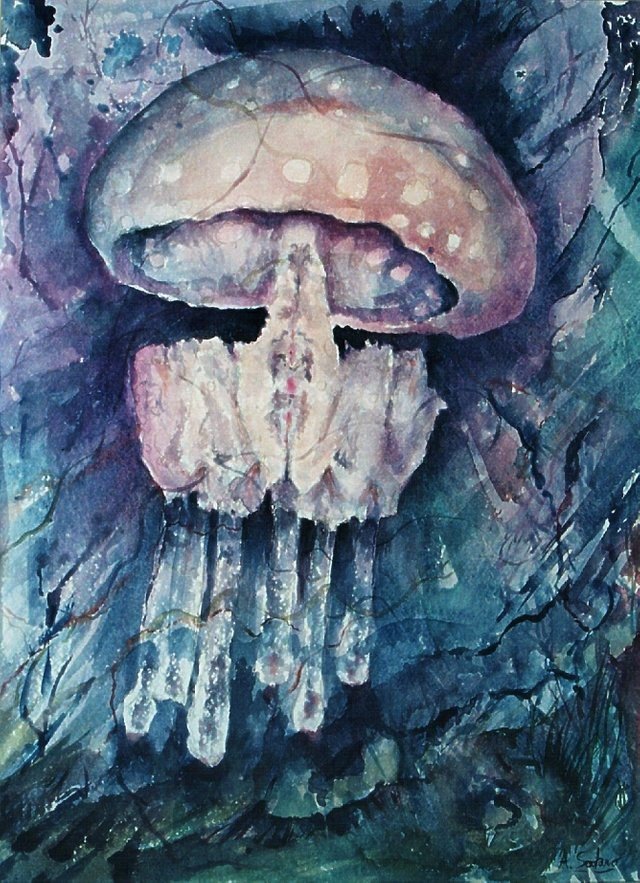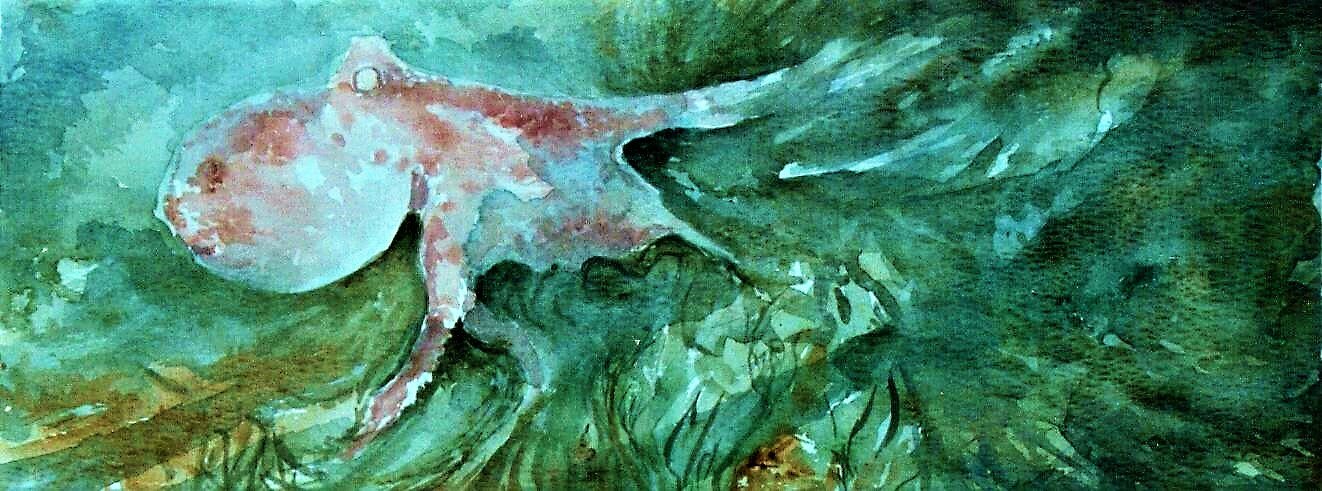
jellyfish and the myth

2 0 1 8
watercolor on paper - private collection - Latina

Il mio acquarello di oggi è tratto dalla serie "abitanti del mare" di cui allego le altre fotografie con i link ai post precedenti.
My watercolor of today is taken from the series "inhabitants of the sea" of which I attach the other photographs with links to previous posts.

@armandosodano/ntopaz--armandosodano--1049418315--ntopaz--2019-01-07-19-13-06--artwork--none

@armandosodano/ntopaz--armandosodano--291300861--ntopaz--2019-01-03-19-48-50--artwork--none
@armandosodano/it-is-easy-to-hide-in-the-blue-watercolor-e-facile-nascondersi-nel-blu-acquarello

medusa
una creatura marina molto affascinante, ma temuta dai bagnanti a causa delle sue cellule urticanti.Conosco molte persone che sono terrorizzate dal far il bagno in mare se hanno visto nei paraggi una medusa. Esiste una paura molto forte di essere punti dai filamenti velenosi, che la medusa usa per difesa ma soprattutto per paralizzare per schock anafilattico le prede.
Esiste una medusa killer chiamata Chironex fleckeri, anche conosciuta come vespa di mare essa ha il suo habitat in Australia, Nuova Guinea, al nord delle Filippine e Vietnam.
E' universalmente riconosciuta come la più pericolosa e mortale per l'uomo. Il suo contatto provoca violenti spasmi muscolari, paralisi, crisi respiratorie ed arresto cardiaco.
La sostanza che inattiva le parti interessate dal contatto è l'aceto, in attesa dell'antidoto da somministrare.
Lungo molte coste australiane, oltre ai cartelli di avviso della presenza di queste creature, le strutture balneari hanno sempre contenitori di aceto disponibili.
Voglio collegare questo essere planctonico alla ben più famosa Medusa mitologica, e molto probabilmente il suo mito nasce proprio da questa creatura molto temuta e dai tentacoli a filamenti velenosi.
Il termine Medusa in greco significa guardiana, protettrice, dal verbo médō cioè proteggere. Questa etimologia probabilmente è dovuta allo scudo di Atena sulla quale era effigiata la sua famosa testa.
In realtà questa figura mitologica così importante, ritratta nelle arti di tutti i tempi, ha una storia collegata ad almeno quattro miti.
Anche Dante Alighieri le concede un posto nell'inferno nel IX Canto dove Virgilio avverte di non girarsi indietro e di tenere gli occhi ben chiusi, al riparo dello sguardo della Gorgone.
Tornando al mito greco, è interessante notare che il suo aspetto in origine, donna bellissima, dopo una fuga d'amore con Poseidone, in un tempio consacrato ad Atena, verrà poi trasformata in orrendo mostro proprio dalla dea della Guerra (Atena), che farà diventare la sua meravigliosa capigliatura un groviglio di serpenti.
Anche nel mito romano Medusa, bellissima, successivamente i suoi capelli furono trasformati in serpenti da Minerva, gelosa.
Nel mito originale, greco, Perseo un semidio, figlio di Zeus e Danae, viene incaricato di uccidere Medusa.
Hermes gli fornì una spada-falce e Atena uno scudo specchiato.
Perseo dapprima uccise le Graie (sorelle delle Gorgoni) poi, recatosi dalle Ninfe del fiume sotterraneo dell'Ade, lo Stige, ebbe in dono dei sandali alati ed un elmo invisibile.
Finalmente giunse dalle Gorgoni, le tre orribili sorelle.
Dormivano, tra centinaia di uomini e belve trasformati in statue di pietra da Medusa.
Atena guidò la mano con la spada-falce di Perseo, egli, usando lo scudo- specchio a riflesso poté guardare Medusa, decapitandola.
Dal suo sangue fuoriuscì Pegaso il cavallo alato con il quale fuggì dall'ira delle due sorelle, non prima di aver messo la testa di Medusa in un sacco.
Il sangue di Medusa bagnò alcune alghe del mare che si pietrificarono in Gorgonie o Corallo rosso.
La leggenda narra che Perseo mostrò la testa di Medusa ad Atlante, un personaggio negativo che tentò di ucciderlo perchè era figlio di Zeus, e lo trasformò nella famosa catena montuosa nord-africana, chiamata per l'appunto Atlante.
Infine Perseo donò ad Atena la testa che la mise come simbolo sul suo vestito, e sullo scudo.
Nell'arte abbiamo delle opere di straordinario impatto visivo, come ad esempio in pittura con Caravaggio:

e nella scultura con Benvenuto Cellini.

Un abbraccio dal mare.
Armando

The jellyfish, a very charming marine creature, but feared by swimmers because of its stinging cells.
I know many people who are terrified of bathing at sea if they saw a jellyfish nearby. There is a very strong fear of being stung by poisonous filaments, which the jellyfish uses for defense but above all to paralyze prey for anaphylactic schock.
There is a killer jellyfish called Chironex fleckeri, also known as sea wasp it has its habitat in Australia, New Guinea, in the north of the Philippines and Vietnam.
It is universally recognized as the most dangerous and deadly for man. His contact causes violent muscle spasms, paralysis, respiratory crises and cardiac arrest.
The substance that inactivates the parts affected by the contact is vinegar, waiting for the antidote to be administered.
Along many Australian coastlines, in addition to warning signs of the presence of these creatures, the bathing facilities always have available vinegar containers.
I want to connect this being planktonic to the much more famous mythological Medusa, and most probably its myth comes from this very feared creature and from tentacles to poisonous filaments.
The term Medusa in Greek means guardian or protector, from the verb médō that is to protect. This etymology is probably due to the shield of Athena on which his famous head was depicted.
In reality this important mythological figure, portrayed in the arts of all time, has a history connected to at least four myths.
Dante Alighieri also gives her a place in hell in the IX Canto where Virgilio warns not to turn back and keep his eyes tightly closed, away from the gaze of the Gorgon.
Returning to the Greek myth, it is interesting to note that her appearance in origin, a beautiful woman, after a flight of love with Poseidon, in a temple consecrated to Athena, will then be transformed into horrible monster by the goddess of war (Athena), who he will make his tangle of snakes become his wonderful hair.
Also in the Roman myth Medusa, beautiful, afterwards her hair was turned into snakes by Minerva, jealous.
In the original Greek myth, Perseus, a demigod son of Zeus and Danae, is charged with killing Medusa.
Hermes provided him with a sword-scythe and Athena a mirrored shield.
Perseus at first killed the Graia (sisters of the Gorgons) then, having come from the Nymphs of the underground river of Hades, he was given the gift of winged sandals and an invisible helmet.
Finally the three horrible sisters came from the Gorgons.
They slept, among hundreds of men and beasts turned into stone statues by Medusa.
Athena guided her hand with Perseus's sword-scythe, using the reflecting mirror-mirror she could look at Medusa, decapitating her.
From his blood Pegasus sprang the winged horse with which he fled from the wrath of the two sisters, not before having put the head of Medusa in a sack.
The blood of Medusa bathed some sea algae that petrified in Gorgonie or Red Coral.
Legend has it that Perseus showed the head of Medusa to Atlas, a negative character who tried to kill him because he was the son of Zeus, and turned it into the famous North African mountain range.
Finally, Perseus gave Athena the head that put her as a symbol on her dress, and on the shield.
In art we have works of extraordinary visual impact, such as in painting with Caravaggio and in sculpture with Benvenuto Cellini.
A hug from the sea.
Armando



- Art teacher
- Curator of cultural activities
- Artistic director and President of the Cultural Association "I Colori della Vita"


